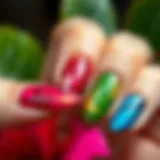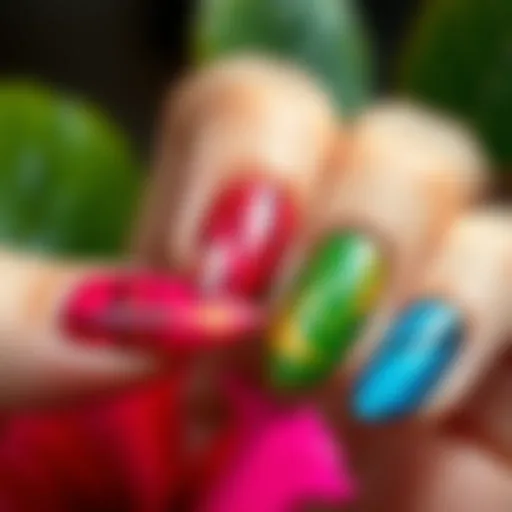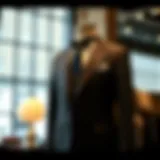Mastering Bow Making: Essential Tools and Techniques

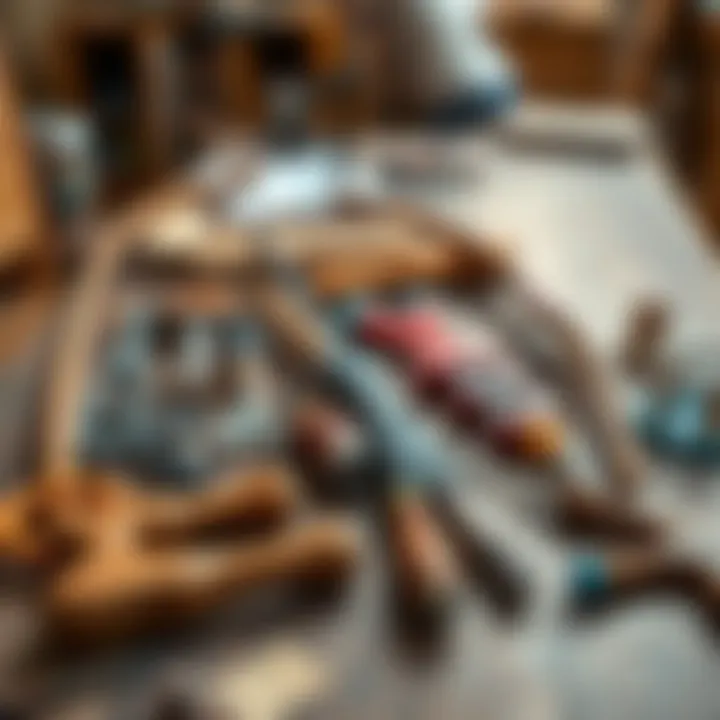
Intro
In the world of fashion and home decor, the bow stands as more than just a decorative afterthought. It has the potential to transform the mundane into the extraordinary. The act of bow making evokes a craft rooted in tradition while also embracing modern creativity. Mastering the art of bow making not only elevates embellishments but also encapsulates personal style and flair, allowing for a unique expression in any design project.
As we embark on this journey into the realm of ribbon crafting, we will explore essential tools and intricate techniques customary to adept bow makers. Whether you are a hobbyist looking to jazz up your gift-wrapping game or a professional designer aiming to incorporate bows into your collections, this guide serves as a roadmap toward acquiring the skills and knowledge necessary for bow craftsmanship. Each detail, from the selection of materials to the final knot, plays a pivotal role in the creation of a stunning bow that catches the eye.
To kick off, we’ll delve into the latest trends shaping the world of bows, merging the buzz of fashion with the satisfaction of hands-on crafting. Here, the journey of creativity begins.
Preface to Bow Making
Bow making, an art that blends creativity with functionality, is a skill cherished by those who appreciate the intricate beauty of ribbon crafting. Whether used in fashion, decor, or as delightful accents on gifts, bows serve a multitude of purposes, adding a touch of elegance and charm. Understanding the basics of bow making equips enthusiasts with the knowledge needed to elevate their creations and express their individuality.
Understanding the Basics
At its core, bow making involves the manipulation of ribbons into visually pleasing shapes. This process isn’t just about tying a ribbon but understanding how to balance proportions, symmetry, and style. A well-crafted bow can transform a simple gift into a stunning presentation or add a dash of flair to an outfit.
One fundamental aspect of bow making is selecting the right type of ribbon. Ribbons come in various textures, colors, and widths, each offering distinct qualities that affect the overall look of the bow. For instance, a satin ribbon boasts a luxe sheen, which can lend a formal feel, while grosgrain ribbons, with their ribbed texture, often convey a more casual and rustic appearance.
Understanding the basic techniques for creating bows is equally crucial. The most common types include the classic bow, the double-loop bow, and the layered bow, each requiring different methods of folding and securing the ribbon. Mastering these techniques allows crafters to adapt and modify designs, catering to specific events or personal tastes.
Historical Overview of Bow Usage
Bows have been utilized for centuries, evolving with cultural trends and societal norms. In ancient times, bows were not solely decorative; they held significance in ceremonies, indicating social status or marking important occasions. For example, in Japan, elaborate knots and bows called 'musubi' were used in wedding ceremonies, symbolizing the everlasting bond between spouses.
In Western fashion, bows began to make their mark during the Renaissance, where they adorned everything from clothing to furniture. Bows in this period were bold, often exaggerated, and crafted from colorful fabrics. As styles changed, so did the applications of bows. They’ve found their way into the likes of haute couture collections and mainstream fashion, with contemporary designers using bows to inject playful femininity into their collections.
Today, bows are not confined to fashion alone; they embellish events, become centerpieces in festive decorations, and enrich our surroundings in countless ways. Whether it's a neatly tied bow on a birthday gift or an intricate bow in a wedding bouquet, their ability to convey sentiment and aesthetics remains timeless.
The Necessity of Bow Making Tools
When diving headfirst into the craft of bow making, one cannot overlook the pivotal role of tools. Much like a chef who relies on their knives, the effectiveness and sophistication of a bow depends significantly on the instruments wielded in its creation. The quality and selection of these tools can elevate a simple ribbon to art, transforming a straightforward craft into something more refined and expressive.
Why Quality Tools Matter
In any crafting endeavor, the tools employed are not just optional accessories—they are fundamental to the process. High-quality tools often lead to more satisfying results, allowing artisans to execute designs with precision. For bow making, this is particularly true as intricate patterns and details require nuanced manipulation. Quality tools reduce frustration during creation, enabling smoother workflow and less time spent troubleshooting issues that arise from inferior equipment.
Moreover, investing in good tools can save money in the long run. While the initial cost might be higher, durable tools withstand wear and tear far better than their cheaper counterparts, thus offering long-term value. Creating bows for fashion and decor often involves a considerable amount of trial and error, and less reliable tools can exacerbate mistakes, compounding the costs involved.
Types of Essential Tools
To craft a bow that truly stands out, certain tools are indispensable. Each has its own unique purpose that supports the bow making process, turning a simple task into an enjoyable art. Below are the essential tools every aspiring and professional bow maker should consider adding to their toolkit.
Bow Making Templates
Bow making templates are a cornerstone of the process, allowing for consistent and beautiful shapes. They come in various designs, making it easier to create bows of different sizes and styles. These templates often feature pre-measured loops and ends, which minimize errors and promote uniformity in bow appearance. Using templates helps maintain the symmetry and proportions that define well-made bows.
A standout feature of these templates is their reusability. Made from durable materials, they can be used repeatedly without losing their accuracy. However, one downside could be that novices might initially find them challenging, needing time to familiarize themselves with how they work.
Precision Scissors
Precision scissors serve as a crucial tool in any bow maker’s arsenal. Unlike ordinary scissors, these are designed for finesse, capable of making clean and accurate cuts that enhance the overall look of the ribbon. The sharpness and control offered by precision scissors is essential as it helps artisans handle delicate materials without causing frays or uneven edges. This is crucial for ensuring that every ribbon is cut to the correct length and shape, directly affecting the final bow design.
While every crafter needs a good pair of scissors, precision scissors are particularly valued in this field. The unique aspect of these scissors lies in their ergonomics, making long cutting tasks less tiring. However, care must be taken to keep them sharp and clean, or they risk becoming ineffective.
Hot Glue Gun
A hot glue gun often earns its place as a favored tool among bow makers. Its ability to bond quickly and securely makes it indispensable, particularly in projects requiring immediate results. The versatility of hot glue affords creators the ability to assemble layers and embellishments with ease, allowing for a splendid variety of designs all while keeping a strong, lasting hold.
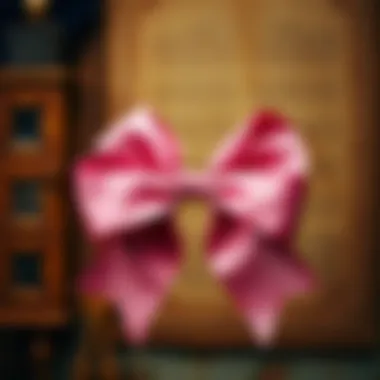

The quick bonding nature of hot glue cannot be overstated; it allows for rapid assembly, especially beneficial when working on multiple bows at once or during time-sensitive projects. However, it’s important to practice caution. The glue can be unforgiving if mishandled, leading to burns or mistakes. Its somewhat permanent nature can also be a drawback; adjustments to glued sections can be tricky without risking damage.
Measuring Tools
Measuring tools, like rulers or fabric measuring tapes, indeed play a key role in bow making. Accuracy in dimensions is essential to ensure that all parts of the bow are proportionate. These tools help creators determine the perfect lengths needed for ribbons, ensuring consistency and symmetry across projects.
An effective measuring tool can greatly improve the efficiency of the crafting process. With precise measurements, makers can execute their designs without excessive iterations or guesswork. However, the downside to measuring tools, particularly if overlooked, is that they might contribute to slowdowns for those not accustomed to meticulous measuring practices. Adjusting to using measuring tools can take some time, but the payoff in better-crafted bows is undeniable.
Good tools do not just simplify a craft; they enhance the art itself, revealing the beauty in skillful execution.
In summary, understanding and investing in the necessary tools for bow making is crucial for anyone looking to master the craft. Each tool carries its unique strengths that contribute profoundly to the process, ensuring a final product that not only looks good but feels personal and meaningful.
Exploring Different Ribbon Types
When diving into the world of bow making, a solid understanding of ribbon types is paramount. Each ribbon brings its unique character, texture, and appeal that can significantly influence the final outcome of your bows. Choosing the right ribbon can uplift a design from mundane to magnificent, and this is where your discernment shines. You’ll find that ribbon comes in a plethora of forms, each serving a specific purpose or aesthetic. Let’s unravel the distinct categories of ribbons and their implications for bow crafting.
Satin vs. Grosgrain
Satin and grosgrain are two heavyweights in the realm of ribbon types. Satin ribbons are known for their luxuriously smooth finish and high sheen. They catch the light beautifully, making them an ideal choice for formal events or elegant decorations. If you're aiming for that classic, sophisticated look in your bows, satin is your friend. However, these ribbons can be a tad slippery, which may lead to a bit of frustration when tying them into bows.
On the flip side, grosgrain ribbons are thicker and more textured. Their ribbed surface gives them a sturdier feel. This quality makes them less prone to slipping and keeps your bows tightly tied. Grosgrain offers a charming casual feel, perfect for everyday decorations or whimsical designs. It's a matter of matching your choice to the occasion—whether you want glam or grit, both types hold their ground in bow making.
Nature and Texture of Ribbons
Ribbons come in various natural characteristics that influence not just their appearance but also how they behave in design. Let’s take a closer look at several key types.
Sheer Ribbons
Sheer ribbons are almost like a whisper of fabric, delicate and ethereal. Their primary attribute is their transparency, allowing for layers of depth when utilized in bow making. This type of ribbon can bring a dreamlike quality to your designs, and they’re especially popular for wedding decorations and soft floral arrangements. However, sheer ribbons can be a little tricky to work with; they tend to fray easily, and their lightweight nature means they require a gentle touch to manipulate correctly. No one wants a bow that unravels at the first gust of wind, so perhaps a blend with sturdier ribbons is wise.
Printed Ribbons
Printed ribbons offer a canvas for creativity. The unique feature of these ribbons is the variety of patterns and images that can be found on them. From seasonal motifs to intricate designs, printed ribbons allow for personalization, making them a fantastic choice for themed events or particulars gifts. However, it should be noted that the effectiveness of a printed ribbon often depends on the quality of the printing process—cheap prints can fade, and the designs can peel. Therefore, investing in high-quality printed ribbons is essential for maintaining a polished look.
Bias Tape
Finally, we have bias tape, which is more utilitarian than decorative. It’s typically used for finishing edges or creating accents rather than being the star of the show. Bias tape beams with versatility, allowing crafters to fold and shape it into various forms for their bows. Its primary characteristic is that it’s cut on the bias, meaning it has a bit of give, and this elasticity can be leveraged for creative tie designs. While it may not offer the glamour of satin or the charm of grosgrain, its practicality cannot be overstated—it reduces bulk and provides clean finishes. This makes it a valuable player in the bow crafting toolkit.
Techniques for Effective Bow Making
The art of bow making goes beyond mere aesthetics. The techniques employed can take a simple ribbon twist and turn it into a captivating statement piece. Understanding these methods not only enhances the appearance of bows but also elevates their functionality in various contexts, from fashion accessories to decorations.
Employing effective bow-making techniques can yield numerous beneficial outcomes. They allow for consistent results, fostering the ability to recreate complex designs with ease. Moreover, mastering techniques enables craftsmen to experiment with creativity, leading to innovations in design that can set one apart in the world of fashion.
Creating the Classic Bow
When it comes to bow making, the classic bow stands as an immortal design. Crafting a classic bow may seem straightforward, but getting it just right requires attention to detail. To start, select a ribbon with a suitable width and stiffness. Wider ribbons bring richness to the bow, while stiffer materials help maintain structure.
- Measure the Ribbon: Determine how large you want your bow to be. Cut the ribbon, remembering to give yourself extra length for the tails.
- Folding Technique: Create loops by folding the ribbon back on itself. The number of loops can vary, but generally, three or four loops work well for that traditional look.
- Tying the Center: Secure the center with a thin piece of wire or another piece of ribbon. This ties everything together and keeps the shape intact.
"A carefully crafted classic bow exudes a charm that can make even the simplest of gifts feel special."
Layering Techniques
Layering techniques are where creativity really shines in bow making. This approach involves stacking different ribbons on top of one another, giving depth and complexity to the design. The choice of materials and patterns can drastically affect the overall outcome.
- Choosing Contrasting Colors: Use ribbons in different shades that complement each other. For example, a simple pastel layer topped with a vibrant striped ribbon can provide a striking visual effect.
- Varying Textures: Combining ribbons made of silk, velvet, and burlap can add dimension. These textures, when layered, create an interesting contrast, making the bow more eye-catching.
- Consider Length Adjustments: When layering, vary the lengths of the ribbons. Longer ribbons cascading behind shorter ones add a lovely elegance.
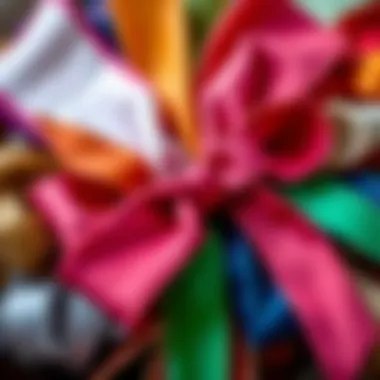
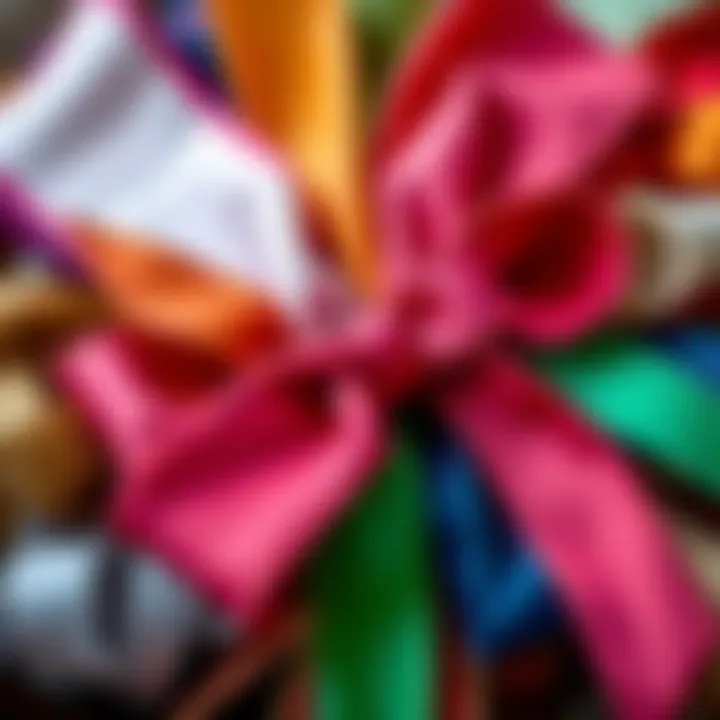
Incorporating Floral Elements
Incorporating floral elements with bows can transform a standard bow into something enchanting. Flowers can range from artificial blooms to fabric floral decorations, each offering unique aesthetics.
- Attaching Floral Decorations: Attach small flowers at the center of the bow or along the tails. Hot glue can ensure a secure bond, but take care not to overdo it. You want the floral accents to enhance the design, not overshadow the bow itself.
- Choosing Seasonal Flowers: Adapting the floral choices to the seasons or specific occasions adds personal flair. Spring might call for cherry blossoms, while autumn may evoke sunflowers or dried lavender.
- Color Coordination: Make sure the colors of the floral elements harmonize with the ribbon. This ensures a cohesive look that feels intentional and refined.
Integrating these techniques not only results in visually arresting designs but also nurtures a deeper appreciation for the elegance and versatility of bows in the crafting and fashion realms. As one embarks on mastering bow making, these techniques serve as foundational steps toward creating signature pieces that leave a lasting impression.
Symbolism and Significance of Bows
Bows hold a unique place in the realm of fashion and decoration, transcending mere aesthetics to evoke emotions, convey messages, and symbolize various aspects of life. The significance of bows extends beyond their visual appeal; they embody cultural values, traditions, and personal expressions. Understanding this symbolism is pivotal for anyone involved in bow making, as it brings depth to the designs created.
Bows in Fashion History
Throughout history, bows have played a significant role in fashion. From the ornate bows of the Rococo period to the minimalistic styles of modern design, they have evolved but remained a staple in the wardrobe. In the 18th century, for instance, bows were often used to adorn dresses, waistcoats, and even hats, showcasing wealth and status. These embellishments were not just decorative; they told stories of class and fashion consciousness.
In the 20th century, designers like Christian Dior reintroduced bows as symbols of femininity and elegance. His collections featured bows that punctuated dresses and accessories, making them essential for the refined look of that era. Today, brands like Valentino and Chanel infuse the contemporary runway with bows, again reinforcing their historic significance.
While bows vary in style—from oversized statement pieces to delicate accents—they continue to be a representation of sophistication and artistry. Incorporating bows into fashion pieces often signifies a nod to tradition while simultaneously showcasing modern creativity. As such, bows are not merely ornamental; they are crucial in communicating a designer's vision and the wearer’s personality.
Cultural Perspectives on Bows
Bows also hold diverse meanings across cultures. In Western societies, they are typically associated with gift-giving and celebrations. Wrapping a present with a bow signifies thoughtfulness and care, expressing a sentiment of joy. In fact, bows are ubiquitous during festive seasons, from Christmas to weddings, representing love, unity, and celebration.
Conversely, in some Eastern traditions, bows symbolize honor and respect. For example, in Japanese culture, the art of wrapping gifts, known as "furoshiki," often utilizes bows not just for aesthetics, but as a gesture of appreciation. The bow's intricate knot can convey a depth of sentiment, elevating the significance of the act of giving.
In certain indigenous cultures, bows are instilled with spiritual significance, where they may serve as symbols of connection to nature or the divine. This highlights how bows can transcend their material form, serving as conduits of cultural expression.
Practical Applications of Bows
Bows are more than just decorative elements; they serve a variety of practical functions in fashion and events. By understanding the significance and applications of bows, one can appreciate their role in elevating not just style but also functionality. The beauty of bows is that they blend utility with aesthetics, making them indispensable in both everyday fashion and special occasions.
Bows in Fashion Accessories
When it comes to fashion accessories, bows often play a central role. They are typically used to embellish bags, headbands, and shoes, creating a focal point that draws attention. A well-placed bow can transform a simple accessory into a statement piece. For example, a plain handbag can turn heads with just a ribbon bow tied around its handle, adding flair without overdoing it.
There is an art to balancing size and style when placing bows on accessories. A small bow can lend an air of sophistication, while a larger one might evoke playfulness. Furthermore, the type of ribbon chosen can alter the accessory’s entire vibe. Satin ribbons convey elegance, whereas grosgrain can suggest a more casual feel. This interplay between the type of ribbon, size, and placement should be carefully considered to achieve the desired outcome.
In fashion, the smallest detail often speaks the loudest. A bow can be the distinction between ordinary and extraordinary.
Ceremony and Decorations
Bows also find their place in ceremonial contexts. From weddings to birthday parties, they help set the tone for an event. The act of incorporating bows into decorations stems from a desire to create a visually pleasing atmosphere. For instance, a wedding arch adorned with bows can accentuate the beauty of the ceremony, creating a magical backdrop for the couple.
When using bows for decoration, one must keep in mind their color and material. Bright colors may signify celebration, while muted shades can suggest sophistication. Additionally, pairing bows with flowers or other elements can create a cohesive design. Ribbons can be used to tie together floral arrangements or drape across tables, enhancing the overall aesthetic of an event.
Overall, whether in fashion accessories or ceremonial decorations, the practical applications of bows are immense. They not only serve to beautify but also to enhance the thematic elements of design and style, making them a versatile tool in any bow maker's collection.
Common Mistakes in Bow Making
Creating beautiful bows might seem like a straightforward task, but it's riddled with opportunities for blunders. Understanding these common mistakes is vital for both beginners and seasoned crafters alike. Identifying what goes wrong ensures that your bows not only look professional but also embody your unique style. Incorporating knowledge of these pitfalls helps save time, resources, and also enhances the overall crafting experience.
Overcomplicating Designs
One of the easiest traps to fall into while making bows is overcomplicating the design. Craft enthusiasts sometimes think that the more intricate the bow, the more impressive it appears. However, this isn't always the case. While complexity can add flair, it often leads to frustration. Too many layers or decorative elements can overwhelm the viewer, making the bow lose its charm.
Here are some key considerations to keep in mind:
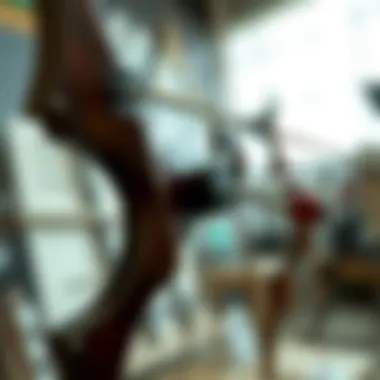
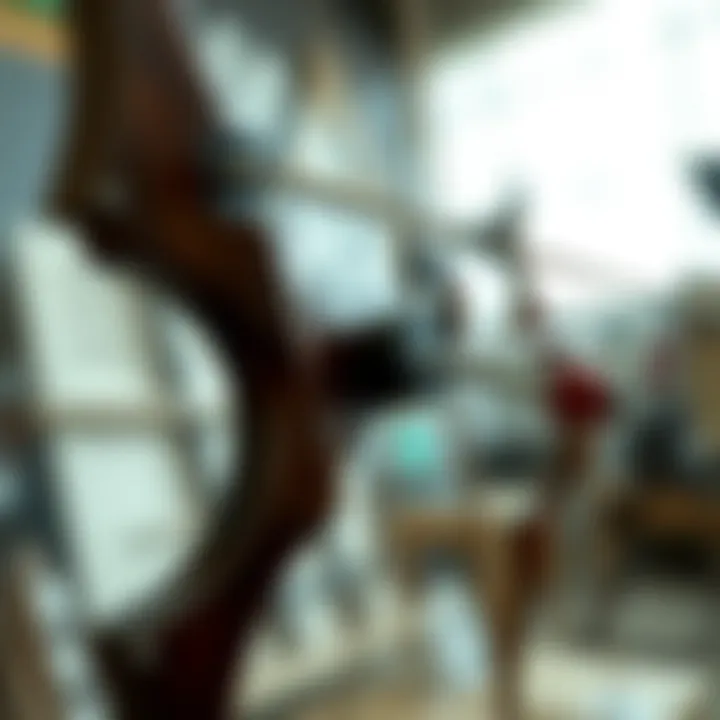
- Less is More: A simple bow created with quality materials often catches the eye better than a chaotic design.
- Focus on Proportions: Balancing the size of each bow's loops, tails, and any additional embellishments is crucial. If one element is off, it can make the entire bow feel uninviting.
- Practice Restraint: Nailing down a singular, striking aspect of a bow can be more effective than incorporating numerous elements aiming for the crowd's attention.
Understanding where to draw the line in design complexity can significantly enhance your bow-making skills. Ultimately, a polished, thoughtful design speaks louder than an intricate one filled with unnecessary frills.
Choosing Inappropriate Materials
Selecting the right materials may seem trivial, yet it's essential for creating functional and visually pleasing bows. Mishaps here often lead to disappointing results.
When choosing materials, consider the following:
- Strength vs. Flexibility: Ribbons need to hold their shape, but they also need to be flexible enough to tie properly. For instance, while satin gives a wonderful sheen, grosgrain offers better structure for larger bows.
- Texture Consideration: A rough textured ribbon can clash with the soft styles of clothing, while sheer ribbons may not provide the support needed if used for larger constructions. The material should complement the purpose of the bow, whether it’s for decor or fashion.
- Color Coordination: Mismatched colors can be jarring. Always evaluate how the colors will interact not only with each other but also with the environment in which the bow will be placed.
"The little details make a big difference; it’s often the materials that define your bow uniqueness."
By being aware of these common mistakes—whether it’s the temptation to overdesign or the selection of ribbons—crafters can elevate their skills and ensure their bows leave a lasting impression.
By grasping these essential aspects, you’ll be well on your way to mastering the art of bow making.
Maintenance and Care of Bow Making Tools
Maintaining your bow making tools is not just about keeping everything tidy. It goes far deeper than that. Proper care extends the longevity of your instruments, ensuring they consistently perform at their best. With good maintenance, you reduce the chances of accidents resulting from faulty tools, which can take the joy out of your crafting experience. Also, regular upkeep helps preserve the quality of the materials you use. Rusty scissors or sticky glue guns can yield less-than-ideal results, and nobody wants that.
Cleaning Techniques
Cleaning your tools may seem like a mundane task, but it is crucial. The first step is to wipe down blades and surfaces with a soft, dry cloth after each use. For sticky residue, especially from hot glue or food-based adhesives, a small amount of isopropyl alcohol on a cotton pad can work wonders. Additionally, be sure to clean the nozzles of your glue guns regularly. Clogged nozzles can cause uneven glue application, ruining your beautifully crafted bows.
- Tip: Avoid using harsh chemicals as they can damage your tools.
- Deep Cleaning: Monthly, consider giving your scissors a more thorough clean by soaking them in warm, soapy water, followed by a gentle scrub with a soft brush. This will help to remove built-up grime, keeping them sharp and ready to go.
"A clean tool is a happy tool" - an old crafter’s saying that rings true across many disciplines.
Storage Recommendations
When it comes to storing bow making tools, out of sight does not mean out of mind. Keeping your tools organized not only makes it easier to find what you need but also protects them from unnecessary damage. Store your scissors in a protective case to prevent blades from dulling. Likewise, keep your measuring tools in a designated drawer or container, avoiding bending or crushing.
- Organizational Ideas:
- Use pegboards to hang tools, easily visible and accessible.
- Invest in a toolbox or craft cart; these can be mobile and provide special compartments for smaller items.
Always remember to keep your tools dry and away from moisture-prone areas, which can promote rust or mold. For fabric or ribbon tools, airflow is key; consider open shelving to maintain a clean, fresh environment.
By taking these basic steps in cleaning and storage, you can ensure that your bow making tools remain in tip-top shape, ready for your next creative venture.
Future Trends in Bow Making
As we step into a new era in the world of crafting, bow making is not left behind. Understanding future trends in bow making is crucial for anyone involved in this art form, whether they are a beginner or a seasoned expert. Changes in materials, technology, and consumer preferences blend new techniques with established practices. This section takes a closer look at what's on the horizon for bow artisans, emphasizing two key trends: the use of sustainable materials and the integration of technology in crafting.
Sustainable Materials in Bow Making
The movement toward sustainability is reshaping numerous industries, and crafting is no exception. Sustainable materials in bow making come into play as consumers become more environmentally conscious. Here’s why this trend matters:
- Environmental Impact: The fashion and craft industries contribute significantly to waste and pollution. By choosing materials like organic cotton ribbons or recycled fabrics, bow makers can minimize their footprint.
- Consumer Demand: People are increasingly drawn to brands that prioritize the planet. Sustainable bows may even become a selling point in their marketing strategies.
- Innovation: As technology improves, more eco-friendly resources are becoming available. This means bow makers can explore new, innovative materials that provide similar quality while promoting sustainability.
Consider using options like hemp, which is durable and biodegradable, or bamboo fiber that is naturally moisture-wicking. Moreover, upcycling old fabric scraps into unique bow designs not only adds artistry but also embraces eco-conscious making.
Integration of Technology
The integration of technology into bow making opens up a world of possibilities that enhances the craft. Let's dive into how tech is elevating the experience:
- Design Software: Crafting software is simplifying the bow design process. Tools like Adobe Illustrator or Canva can assist in visualizing designs before physically creating them.
- Digital Templates: Pre-made digital patterns can save time and enhance precision, allowing crafters to focus more on creativity rather than measurement mishaps.
- 3D Printing: Already prevalent in many industries, 3D printing can create bow-making tools or even bows themselves, pushing the boundaries of creativity.
- Online Communities: Platforms such as Reddit or specialized Facebook groups connect bow makers, sharing insights, designs, and encouragement. These communities foster learning and collaboration that is transformative.
"The future belongs to those who believe in the beauty of their dreams." - Eleanor Roosevelt
It's clear that the combination of sustainability and technology can reshape the bow making landscape. As the demand for more eco-friendly products grows alongside advancements in tech, the blend can lead to unprecedented creativity and efficiency in bow crafting.
In summary, as the bow-making community evolves, focusing on sustainable materials and embracing technology will be not just advantageous but essential for survival and relevance. These trends are poised to change how bows are viewed and made, ensuring that this craft remains vibrant and progressive.


